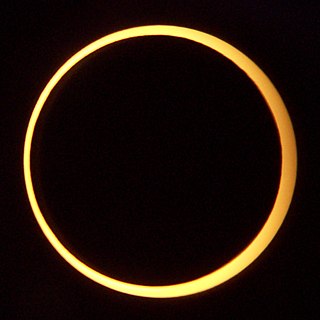Solar eclipse of May 20, 2012
| Solar eclipse of May 20, 2012 | |
|---|---|

From Middlegate, Nevada
|
|
| Type of eclipse | |
| Nature | Annular |
| Gamma | 0.4828 |
| Magnitude | 0.9439 |
| Maximum eclipse | |
| Duration | 346 sec (5 m 46 s) |
| Coordinates | 49°06′N 176°18′E / 49.1°N 176.3°E |
| Max. width of band | 237 km (147 mi) |
| Times (UTC) | |
| (P1) Partial begin | 20:56:07 |
| (U1) Total begin | 22:06:17 |
| Greatest eclipse | 23:53:54 |
| (U4) Total end | 1:39:11 |
| (P4) Partial end | 2:49:21 |
| References | |
| Saros | 128 (58 of 73) |
| Catalog # (SE5000) | 9535 |
An annular solar eclipse took place on May 20, 2012 (May 21, 2012 in local time in the Eastern Hemisphere), with a magnitude of 0.9439. A solar eclipse occurs when the Moon passes between Earth and the Sun. Annular solar eclipse occurs when the Moon's apparent diameter is smaller than the Sun's, blocking most of the Sun's light and causing the Sun to look like an annulus (ring). An annular eclipse appears as a partial eclipse over a region of the Earth thousands of kilometres wide.
It was the first annular eclipse in the continental U.S. since the solar eclipse of May 10, 1994 which was also the previous eclipse of this series Solar Saros 128.
It was predicted that the antumbra would pass over Hong Kong but due to weather it was not observable.
Annular solar eclipse of May 21, 2012 in Keelung, Taiwan
Tokushima City, Japan
Aichi Prefecture, Japan
Kōfu, Japan
23 wards, Tokyo, Japan
Video from Tokyo, Japan
Crescent shadows on an outdoor wall in San Francisco, California.
Crescent shaped shadows from tree on a wall in San Francisco, California
...
Wikipedia

